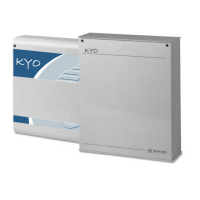61
®®
Section 3 - Programming from PC
Type
This section will allow you to select the operating mode of the 8 telephone Num-
bers.
To program the Type:
1. select the Telephone Number;
2. program the following parameters for the selected Telephone Number.
zz
zz
z Telemonitoring - This option will allow the Control panel to communicate
with the Central Station. It will be necessary to program parameters in the
Telemonitoring section.
zz
zz
z Voice Message - This option will allow the Control panel to send a Voice
Message (this option requires the NC2/VOX).
zz
zz
z Teleservice - This option will allow the Control panel to manage Teleservice
calls.
zz
zz
z None - No service.
Partitions
This section will allow you to assign the selected Telephone Number to the Parti-
tions. It is possible to change a Telephone Number by entering a Main User Code
at a Keypad (the Code and Keypad must be assigned to the Partition of the Tel-
ephone number concerned).
The ‘Teleservice’ option will activate the Reporting Protocol list (below).
zz
zz
z Protocol - The Reporting protocol is usually assigned by the Central Station.
This system supports the following formats:
ADEMCO / SILENT KNIGHT - Slow 10 baud - 3/1, 4/1, 4/2
ADEMCO / SILENT KNIGHT - Fast 14 baud - 3/1, 4/1, 4/2
FRANKLIN / SECOA / DCI-VERTEX - Fast 20 baud - 3/1, 4/1, 4/2
RADIONICS - 40 baud - 3/1, 4/1, 4/2
SCANTRONIC - 10 baud - 3/1, 4/1, 4/2
CONTACT ID
CESA
zz
zz
z Customer Code - This code is usually assigned by the Central Station, and
allows their operator to identify the system (user, location, type of system,
etc.).
The Customer Codes must have 4 digits (5 for CESA protocol): 0 through
9 and A to F (hexadecimal).
For Contact ID — ‘0’ and ‘A’ have the same value.
For Pulse protocols — ‘0’ corresponds to 10 pulses, whereas ‘A’ corresponds
to ‘0’ pulses (empty digit).
When using Pulse protocols with 3 digit codes, the fourth digit must be
programmed as ‘A’.

